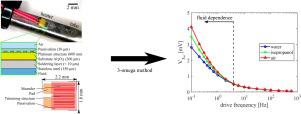Sensors and Actuators A: Physical ( IF 4.1 ) Pub Date : 2020-11-07 , DOI: 10.1016/j.sna.2020.112419 Ralf E. Bernhardsgrütter , Christoph J. Hepp , Katrin Schmitt , Martin Jägle , Hans-Fridtjof Pernau , Jürgen Wöllenstein

|
This article presents a platinum thin-film sensor to distinguish fluids via their thermal properties by applying the 3-method. The thin film element is attached to a stainless steel tube piping the fluid. The fluids of interest in this article are gas (air), water, and alcohol (isopropanol). The progress claims include: First, the 3-method is applied to distinguish fluids which are not directly in contact with the sensitive structure. Second, the 3-method is applied on a meander structure instead of the commonly used straight strip. These two features should lead to high flexibility, high corrosion resistance and high hygiene and safety standards in applications. Third, because of the complexity of the sensor structure, a simplified analytical model is elaborated and a numerical simulation is conducted to obtain a profound understanding of the sensor's behavior. Based on these results, the sensor is designed and manufactured by standard thin film technology. The agreement between experiment and simulation results is within 5%. These findings can play a key role for future in-line sensors in process control systems e.g. in the food industry. Moreover, a deep understanding of the sensor's physical behavior with respect to its thermal properties can lead to a feasible combination of the 3-method and thermal anemometry to achieve a robust thermal flow sensor, which is able to compensate the dependence on the thermal properties of different fluids.
中文翻译:

迈向耐用的薄膜传感器,使用 -方法
本文介绍了一种铂薄膜传感器,通过应用3-方法。薄膜元件连接到输送流体的不锈钢管上。本文关注的流体是气体(空气),水和酒精(异丙醇)。进度声明包括:一,三-方法用于区分不直接与敏感结构接触的流体。二,三-方法应用于曲折结构,而不是通常使用的直条。这两个特征应导致在应用中具有较高的柔韧性,较高的耐腐蚀性以及较高的卫生和安全标准。第三,由于传感器结构的复杂性,详细阐述了简化的分析模型,并进行了数值模拟,以深刻理解传感器的行为。基于这些结果,该传感器是通过标准薄膜技术设计和制造的。实验与仿真结果之间的一致性在5%以内。这些发现对于将来的在线传感器在过程控制系统(例如食品工业)中可以发挥关键作用。此外,对传感器的深入了解-方法和热风速测定法,以实现强大的热流传感器,该传感器能够补偿对不同流体的热性能的依赖性。









































 京公网安备 11010802027423号
京公网安备 11010802027423号